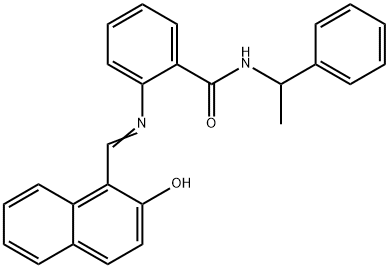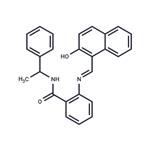Description
Sirtinol (410536-97-9) is an inhibitor of sirtuin family enzymes including human SIRT1 (IC50=60 μM), human SIRT2 (IC50=58 μM), and yeast Sir2 (IC50=48 μM) with no inhibition of human HDAC1. Active in vivo and in purified enzyme studies. Cell permeable.
Uses
Sirtinol is a cell permeable specific inhibitor of sirtuin NAD-dependant deacetylases
Uses
Sirtinol is a known inhibitor of the NAD+-Dependent Protein Desuccinylase and Demalonylase Sirt5 and exhibits anticancer properties.
Definition
ChEBI: Sirtinol is a benzamide obtained by formal condensation of the carboxy group of 2-{[(2-hydroxy-1-naphthyl)methylene]amino}benzoic acid with the amino group of 1-phenylethylamine. It has a role as an anti-inflammatory agent, an EC 3.5.1.98 (histone deacetylase) inhibitor and a Sir2 inhibitor. It is a member of benzamides, an aldimine and a member of naphthols. It is functionally related to an anthranilic acid.
General Description
A cell-permeable 2-hydroxy-1-naphthaldehyde derivative that acts as a specific and direct inhibitor of the sirtuin class of deacetylase activity with no affect on human HDAC1 (IC
50 = 48 μM, 131 μM and 58 μM for ySir2, hSIRT1 and hSIRT2, respectively). Reported to inhibit Sir2p transcriptional silencing activity
in vivo (IC
50 = 25 μM), and NAD-dependent histone deacetylase activity of purified recombinant yeast Sir2p and human SIRT2
in vitro (IC
50 = 70 μM and 40 μM, respectively). A 10 mM (1 mg/254 μl) solution of Sirtinol (Cat. No.
566321) in DMSO is also available.
Biological Activity
Cell-permeable, selective sirtuin deacetylase inhibitor (IC 50 values are 38, 68 and 131 μ M at SIRT2, Sir2p and SIRT1 respectively) that has no effect on HDAC1 activity. Significantly decreases growth and viability of PCa and HEK293T cells in vitro .
Biochem/physiol Actions
Cell permeable: yes
References
1) Ota et al. (2006) SIRT1 inhibitor, Sirtinol, induces senescence-like growth arrest with attenuated Ras-MAPK signaling in human cancer cells; Oncogene, 25 176
2) Mai et al. (2005) Design, synthesis and biological evaluation of sirtinol analogues as class III histone/protein deacetylase (Sirtuin) inhibitors; J. Med. Chem. 48 7789
3) Grozinger et al. (2001) Identification of a class of small molecule inhibitors of the sirtuin family of NAD-dependent deacetylases by phenotypic screening; J. Biol. Chem. 276 38837
4) Koering et al. (2002) Human telomeric position effect is determined by chromosomal context and telomeric chromatin integrity; EMBO Rep. 3 1055


